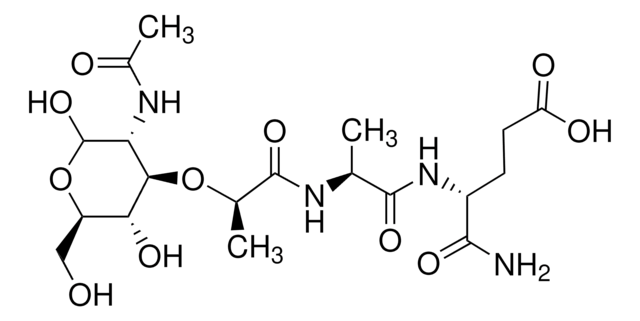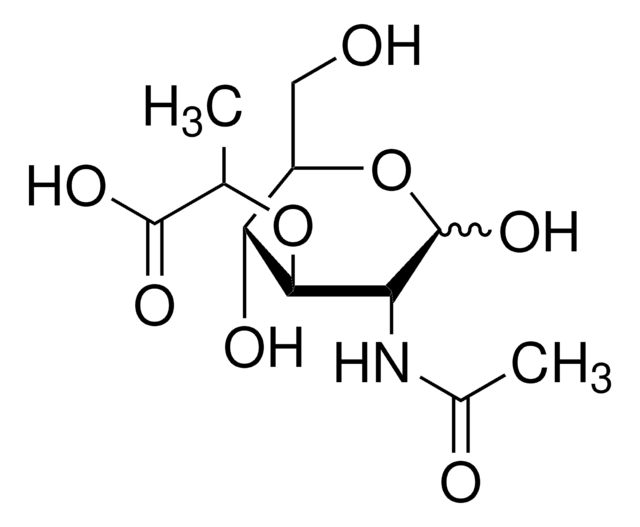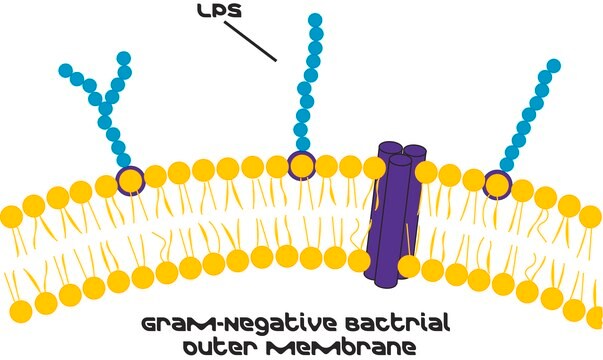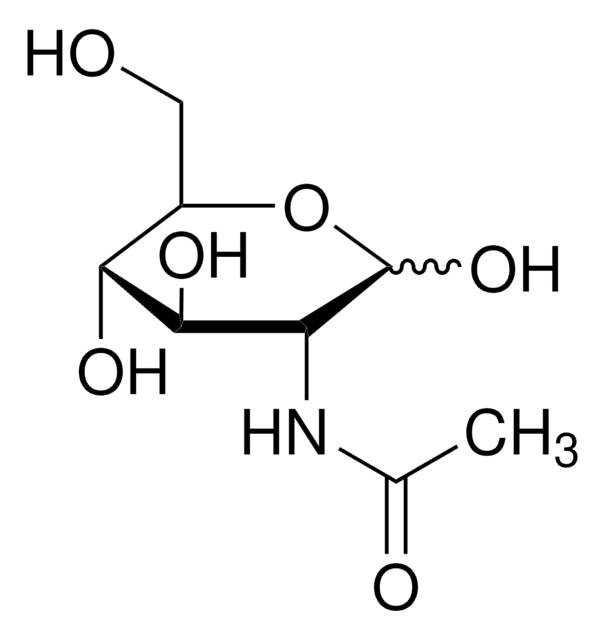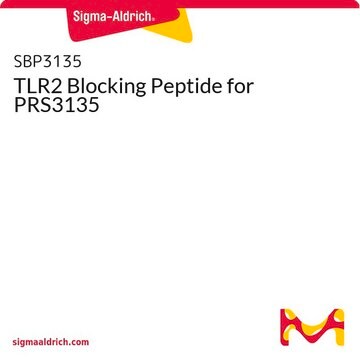추천 제품
관련 카테고리
일반 설명
Peptidoglycan.is a biopolymer that is a major component of the cell walls of Gram-positive bacteria. Peptidoglycan consists of a carbohydrate backbone of alternating units of N-acetyl glucosamine and N-acetyl muramic acid and is modified with both D- and L-amino acids. N-Acetyl muramic acid residues are cross-linked with oligopeptides. The terminal peptide is D-alanine although other amino acids are present as D-isomers.
애플리케이션
Peptidoglycan may be used for the activity estimation of lytic enzymes (e.g. lyticase). It is recommended to use a peptidoglycan concentration of 0.15-3 μg/ml in water or buffer and measuring at 450 nm. The peptidoglycan is not soluble but produces a suspension in water.
Peptidoglycan activates the Toll-like receptor 2 (TLR2), present in mammalian cells for the stimulation of lymphocytes. It may also function as an antagonist of Poly (I:C).
Peptidoglycan activates the Toll-like receptor 2 (TLR2), present in mammalian cells for the stimulation of lymphocytes. It may also function as an antagonist of Poly (I:C).
포장
Bottomless glass bottle. Contents are inside inserted fused cone.
Storage Class Code
11 - Combustible Solids
WGK
WGK 3
Flash Point (°F)
Not applicable
Flash Point (°C)
Not applicable
개인 보호 장비
Eyeshields, Gloves, type N95 (US)
이미 열람한 고객
Angela Cuttitta et al.
Fish & shellfish immunology, 67, 86-94 (2017-06-06)
Gene family encoding allograft inflammatory factor-1 (AIF-1) is well conserved among organisms; however, there is limited knowledge in lower organisms. In this study, the first AIF-1 homologue from cnidarians was identified and characterised in the sea anemone Anemonia viridis. The
Yichao Xie et al.
Fish & shellfish immunology, 106, 384-392 (2020-08-11)
Antimicrobial peptide (AMP) is a crucial component of the innate immune system in crustaceans. In mud crab, Scylla paramamosain, a commercially important species, a glycine-rich antimicrobial peptide (Spgly-AMP) gene was newly identified and putatively encoded a 26aa signal peptide and
Christian Stelter et al.
PloS one, 6(6), e20749-e20749 (2011-06-23)
Intestinal inflammation induces alterations of the gut microbiota and promotes overgrowth of the enteric pathogen Salmonella enterica by largely unknown mechanisms. Here, we identified a host factor involved in this process. Specifically, the C-type lectin RegIIIβ is strongly upregulated during
Qian Zhu et al.
Fish & shellfish immunology, 100, 9-17 (2020-03-05)
Interleukin (IL)-11 is a multifunctional cytokine that exerts a series of important immunomodulatory effects and exists in many tissues and cells. A 1106-bp nucleotide sequence representing the complete cDNA of IL-11 was obtained from large yellow croaker (Larimichthys crocea), containing
Yu-Yuan Chen et al.
PloS one, 9(12), e115232-e115232 (2014-12-18)
Invertebrates rely on an innate immune system to combat invading pathogens. The system is initiated in the presence of cell wall components from microbes like lipopolysaccharide (LPS), β-1,3-glucan (βG) and peptidoglycan (PG), altogether known as pathogen-associated molecular patterns (PAMPs), via
문서
Peptidoglycans
자사의 과학자팀은 생명 과학, 재료 과학, 화학 합성, 크로마토그래피, 분석 및 기타 많은 영역을 포함한 모든 과학 분야에 경험이 있습니다..
고객지원팀으로 연락바랍니다.
